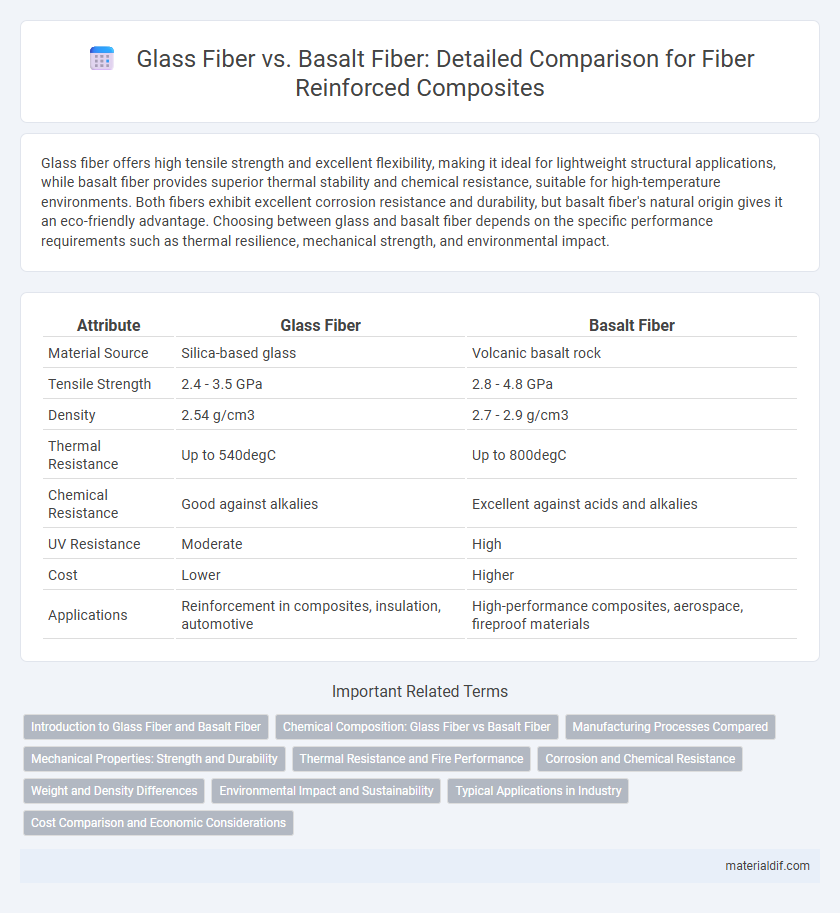Glass fiber offers high tensile strength and excellent flexibility, making it ideal for lightweight structural applications, while basalt fiber provides superior thermal stability and chemical resistance, suitable for high-temperature environments. Both fibers exhibit excellent corrosion resistance and durability, but basalt fiber's natural origin gives it an eco-friendly advantage. Choosing between glass and basalt fiber depends on the specific performance requirements such as thermal resilience, mechanical strength, and environmental impact.
Table of Comparison
| Attribute | Glass Fiber | Basalt Fiber |
|---|---|---|
| Material Source | Silica-based glass | Volcanic basalt rock |
| Tensile Strength | 2.4 - 3.5 GPa | 2.8 - 4.8 GPa |
| Density | 2.54 g/cm3 | 2.7 - 2.9 g/cm3 |
| Thermal Resistance | Up to 540degC | Up to 800degC |
| Chemical Resistance | Good against alkalies | Excellent against acids and alkalies |
| UV Resistance | Moderate | High |
| Cost | Lower | Higher |
| Applications | Reinforcement in composites, insulation, automotive | High-performance composites, aerospace, fireproof materials |
Introduction to Glass Fiber and Basalt Fiber
Glass fiber, composed primarily of silica-based materials, offers high tensile strength, excellent thermal insulation, and resistance to corrosion, making it a popular choice in construction and automotive industries. Basalt fiber, derived from volcanic rock, exhibits superior mechanical properties, enhanced durability, and exceptional chemical stability, positioning it as an eco-friendly alternative with increased resistance to high temperatures and harsh environmental conditions. Both fibers serve critical roles in composite materials, but basalt fiber's natural origin provides advantages in sustainability and long-term performance.
Chemical Composition: Glass Fiber vs Basalt Fiber
Glass fiber primarily consists of silica (SiO2) combined with alumina (Al2O3), calcium oxide (CaO), and boron oxide (B2O3), offering excellent chemical resistance and thermal stability. Basalt fiber is derived from natural volcanic rock, rich in silica, alumina, and iron oxide (Fe2O3), which imparts superior mechanical strength and enhanced resistance to alkalis and acids compared to glass fiber. The chemical composition of basalt fiber results in higher durability and corrosion resistance, making it suitable for aggressive environmental applications where glass fiber might degrade more rapidly.
Manufacturing Processes Compared
Glass fiber manufacturing involves melting raw materials such as silica sand, soda ash, and limestone at temperatures around 1,700degC, followed by extrusion through fine orifices to form continuous filaments, which are then cooled and wound. Basalt fiber production starts with melting crushed basalt rock at approximately 1,400degC, eliminating the need for additives or chemical processing, resulting in a more environmentally friendly process. Both fibers require drawing, sizing, and curing stages, but basalt fiber's simpler raw material preparation contributes to lower energy consumption and fewer emissions compared to glass fiber manufacturing.
Mechanical Properties: Strength and Durability
Glass fiber exhibits high tensile strength and excellent flexibility, making it a popular choice for applications requiring strong yet lightweight reinforcement. Basalt fiber offers superior durability and heat resistance, with higher compressive strength and better resistance to chemical corrosion compared to glass fiber. These mechanical properties make basalt fiber more suitable for harsh environments, while glass fiber remains favored for cost-effective, versatile structural applications.
Thermal Resistance and Fire Performance
Basalt fiber exhibits superior thermal resistance compared to glass fiber, maintaining structural integrity at temperatures up to 870degC, while E-glass fiber degrades around 540degC. In fire performance, basalt fiber is inherently non-combustible and releases no toxic fumes, enhancing safety in high-temperature applications. Glass fiber, though heat-resistant, can emit hazardous gases during combustion, making basalt fiber a preferable choice for extreme thermal environments.
Corrosion and Chemical Resistance
Glass fiber exhibits strong corrosion resistance but can be vulnerable to alkaline environments, leading to potential degradation over time. Basalt fiber offers superior chemical resistance, particularly against acids and alkalis, making it more durable in harsh industrial settings. Both fibers maintain structural integrity in corrosive conditions, but basalt fiber generally provides enhanced longevity and stability.
Weight and Density Differences
Glass fiber typically has a density of around 2.5 g/cm3, making it heavier than basalt fiber, which has a density closer to 2.7-3.0 g/cm3. Despite basalt fiber's higher density, its superior mechanical properties often result in lighter composite structures when used in applications requiring high strength-to-weight ratios. The weight difference between these fibers influences material selection for industries prioritizing lightweight yet durable construction.
Environmental Impact and Sustainability
Glass fiber production consumes significant energy and relies on non-renewable raw materials, contributing to higher carbon emissions compared to basalt fiber. Basalt fiber is derived from natural volcanic rock, offering greater sustainability through abundant raw material availability and lower energy requirements during manufacturing. Its recyclability and durability further enhance environmental benefits by reducing waste and extending product lifespan in various applications.
Typical Applications in Industry
Glass fiber is widely used in construction, automotive, and marine industries due to its high tensile strength, lightweight nature, and cost-effectiveness. Basalt fiber excels in high-temperature and chemical-resistant applications such as aerospace, defense, and infrastructure projects, benefiting from its superior thermal stability and environmental durability. Both fibers serve crucial roles in manufacturing composites, with glass fiber favored for general-purpose reinforcement and basalt fiber preferred for more demanding environments.
Cost Comparison and Economic Considerations
Glass fiber offers a lower initial cost compared to basalt fiber, making it a more budget-friendly option for large-scale industrial applications. Basalt fiber, while more expensive upfront, provides superior durability and chemical resistance, potentially reducing long-term maintenance and replacement expenses. Economic considerations must balance the higher price of basalt fiber against its extended lifespan and performance benefits to determine overall cost-effectiveness.
Glass Fiber vs Basalt Fiber Infographic

 materialdif.com
materialdif.com